Research Article
Calibrating the Estimated Health Age Via Metabolism Index Using GH-Method: Math-Physical Medicine (No. 313)
4458
Views & Citations3458
Likes & Shares
The author became interested in geriatrics in 2019, especially in regard to longevity. Prior to that in 2010, he studied and researched metabolism, endocrinology, and chronic diseases. In 2014, he applied topology concept and engineering finite element method to develop a mathematical model for estimating the state of human metabolism. The collected massive data amount of ~2 million on metabolism and diseases allowed him to extend his research work into longevity. In January 2020, he published his first paper on geriatrics regarding effective health age. In July 2010, he further developed a simplified APP (application software) on the iPhone for estimating patients’ effective health age (“Health Age”) with or without chronic diseases to compare against their biological real age (“Real Age”). He then published his findings in paper, No. By using data from four key medical conditions based on the health examination reports (4 biomarkers: Weight, glucose, blood pressure and lipids) and six lifestyle details input by the user (diet, water, exercise, sleep, stress and daily life routines), this APP could instantly calculate and show both metabolism index (MI) score, and Health Age on the iPhone. This paper aims at calibrating the accuracy of his estimated health age by varying one of its important parameters, amplification factor (AF), in his defined arithmetical formula:
Effective Health Age = Real Biological Age * (1+((MI-0.735)/0.735)/Amplification factor)
A healthy person or APP user should have lower values on the biomarkers and lifestyle details, which results in a lower MI score. This lower MI score (means healthier) would then make the health age below the real age, and vice versa. By maintaining a good lifestyle program with healthy medical examination outcomes, the overall metabolism status will be above standard; therefore, the immune system will be strong and effective. With strong immunity, their bodies will be able to defend against various diseases, including complications from chronic diseases (50% of death cases), cancers (29% of death cases), and infectious diseases (11% of death cases). As a result, healthy people will most likely become members of the “longevity club”. When the author developed his arithmetical formula of health age, he inserted an AF inside the formula (see above). The reason is two-fold, first: AF could be used later for calibrating the accuracy of end results, and second, it would further raise the user’s awareness of metabolism importance on longevity. In this investigation, he chose AF values of 1, 2, and 4 to cover a reasonable range between the upper and lower bound. Based on the results of feasibility analysis in this article, he feels that the AF value of 2 seems to be the most suitable for real applications.
The following list demonstrates the age differences of these three groups: The turning point date is 8/23/2014 where his MI reached the break-even line of 0.735.
Pre-8/23/2014(worse performance): Health age = 74.5 & real age = 66.3
Post-8/23/2014(better performance): Health age = 63.6 & real age = 70.5
Total period: (average performance); Health age = 66.7 & real age = 69.3
From the information above, it is obvious that his health conditions have greatly improved; therefore, his body shows a younger age than his real age. As seen in Figure 4, it is clear that he has saved his own life, and hopefully, he can live a longer and healthier life. This article describes his sensitivity analysis in order to achieve a better estimated health age using MI scores as his tool. He decided to use the AF value of 2 for the calculation of his estimated health age. The difference between his health age and real age is -2.6 years using his “total average” daily data over 8.5 years from 1/1/2012 to 8/15/2020. However, by using his “annual” data for the calculation, then his age difference was +8 years in 2012 (health age was 72 with real age of 64) and -9 years in 2020 (health age is 64 with real age of 73). This tool can be used by people with and without chronic diseases. Metabolism is the fundamental building block for diabetes control, health maintenance, and longevity. The author developed this model, approach, and simple formula by himself; therefore, he must conduct research on this equation’s two vital influential factors, MI and AF. He spent 7 years on MI research and has a strong understanding of the MI’s applicability. AF is just a simple adjustment factor that makes the health age match closely to the user’s real medical and health conditions as much as possible. The author is not a fortune teller who uses a crystal ball to predict other people’s future life expectancy, but rather he is a scientist who applies solid scientific techniques with biomedical evidence to develop a simple arithmetic formula which can serve as a useful tool for the general population’s health maintenance and longevity purposes.
Keywords: Real age, Health age, Amplification factor
INTRODUCTION
The author became interested in geriatrics in 2019, especially in regard to longevity. Prior to that in 2010, he studied and researched metabolism, endocrinology, and chronic diseases. In 2014, he applied topology concept and engineering finite element method to develop a mathematical model for estimating the state of human metabolism. The collected massive data amount of ~2 million on metabolism and diseases allowed him to extend his research work into longevity. In January 2020, he published his first paper on geriatrics regarding effective health age [1]. In July 2010, he further developed a simplified APP (application software) on the iPhone for estimating patients’ effective health age (“Health Age”) with or without chronic diseases to compare against their biological real age (“Real Age”). He then published his findings in paper [2]. By using data from four key medical conditions based on the health examination reports (4 biomarkers: weight, glucose, blood pressure, and lipids), and six lifestyle details input by the user (diet, water, exercise, sleep, stress, and daily life routines), this APP could instantly calculate and show both metabolism index (MI) score, and Health Age on the iPhone.
This paper aims at calibrating the accuracy of his estimated health age by varying one of its important parameters, amplification factor (AF), in his defined arithmetical formula:
Effective Health Age = Real Biological Age * (1+((MI-0.735)/0.735)/Amplification factor)
METHODS
For the past 10 years, the author spent ~30,000 h, from 2010 to 2020, to conduct his research on chronic diseases and its complications, along with endocrinology, specifically focusing on metabolism and glucose.
Initially, from 2010 to 2013, he self-studied internal medicine and food nutrition. He specifically focused on six chronic diseases, obesity, diabetes, hypertension, hyperlipidemia, cardiovascular disease (CVD) and stroke, and chronic kidney disease (CKD). In 2014, he spent the entire year to develop a complex mathematical metabolism model which includes 4 body output categories (weight, glucose, blood pressure, lipids) and 6 body input categories (food, water, exercise, sleep, stress, daily life routine regularity). There are about 500 detailed elements included in these 10 categories. Since using a theoretical approach to deal with a dataset of 10 categories with 500 elements, the problem of identifying and solving all possible inter-relationships among them would be an immense task. In theory, this task would involve a big number of calculation steps of “500!”. This kind of pure theoretical approach is a huge undertaking without any obvious benefit; therefore, he adopted an approach of applying mathematical concept that is topology. In addition, he applied a practical engineering modeling technique such as finite element method to seek a quicker but still accurate solution for this complicated biomedical system. At the end, he was able to develop a mathematical metabolism model embedded in a specially designed application software known as the eclaire MD on the iPhone for his daily use in order to maintain his health conditions and serves as a useful research tool for his ongoing medical research projects [3-7].
During the development process, he has defined two more new variables, metabolism index (MI) and general health status unit (GHSU), where GHSU is the 90-days moving average MI that is similar to the relationship between HbA1C and 90-days moving average glucoses. The results of this dynamic model can be expressed through these two newly defined variables, MI and GHSU, to describe a person’s overall health status and also able to identify some shortcomings in a specific health area at any moment in time. The break-even line is 0.735, or 73.5%, above it would be unhealthy and below it would be healthy.
In the following two-year period, 2015 and 2016, he dedicated his time to research four prediction models related to his four key measured diabetes biomarkers, i.e. weight, PPG, FPG, and A1C. As a result, from using his own developed prediction tools, within a decade, his weight reduced from 220 lbs. (100 kg) to 169 lbs. (77 kg), waistline from 44 inches (112 cm) to 32 inches (82 cm), glucose from 280 mg/dL to 108 mg/dL, and A1C from 10% to 6.2%. The most remarkable accomplishment is that he no longer takes any diabetes medications since 12/8/2015. As a result, he enjoyed additional improvements on his overall health, particularly from 2017 to 2020, by controlling his diabetes and five of its various complications. In addition, through his geriatric research on effective health age, he is able to identify his perspective of life longevity [1].
Hsu [8] further described his idea, concept, and process on how to develop a simplified tool of this sophisticated eclaire MD system. Based on his eclaire MD’s design architecture, he has evolved it into this simple and useful APP tool for consumers.
This product still contains ten metabolism categories, four for medical conditions and six for lifestyle details. He then copies the “engine” portion from his existing eclaire MD metabolism mathematical model as the central processing unit (CPU) of this simple tool in order to calculate the MI value quickly and accurately. In the last step, he takes the “equation” to calculate the effective health age based on MI score [2], see below:
Effective Health Age = Real Biological Age * (1+((MI-0.735)/0.735)/Amplification factor)
Effective Health Age = Real Biological Age * (1+((MI-0.735)/0.735)/Amplification factor)
A healthy person or APP user should have lower values on the biomarkers and lifestyle details, which result in a lower MI score. This lower MI score (means healthier) would then make the health age below the real age, and vice versa. By maintaining a good lifestyle program with healthy medical examination outcomes, the overall metabolism status will be above standard; therefore, the immune system will be active and effective. With a strong immunity, their bodies will be able to defend against various diseases, including complications from chronic diseases (50% of death cases), cancers (29% of death cases), and infectious diseases (11% of death cases). As a result, healthy people will most likely become members of the “longevity club”.
When the author developed his arithmetical formula of health age, he inserted an AF inside the formula (see above). The reason is two-fold, first: AF could be used later for calibrating the accuracy of end results, and second, it would further raise the user’s awareness of metabolism importance on longevity. In this investigation, he chose AF values of 1, 2, and 4 to cover a reasonable range between the upper and lower bound. Based on the results of feasibility analysis in this article, he feels that the AF value of 2 seems to be the most suitable for real applications.
RESULTS
Figure 1 illustrates the high correlation, 98% to 99%, between health age and MI where the AF value is equal to 1 and 2. However, when the AF value is 4, their correlation coefficient drops down to 78% (which is still high). In actuality, the health age formula is based on MI value; therefore, the high correlations are expected. In the “AF value of 4” case, the deviation between health age curve and MI curve becomes much wider after 2018. The lower MI values after 2018 (healthier years) divided by a higher AF of 4 would push the health age higher. It is a pure and simple numerical operation result which also hints that the AF value of 4 may be over-correcting the estimated health age.
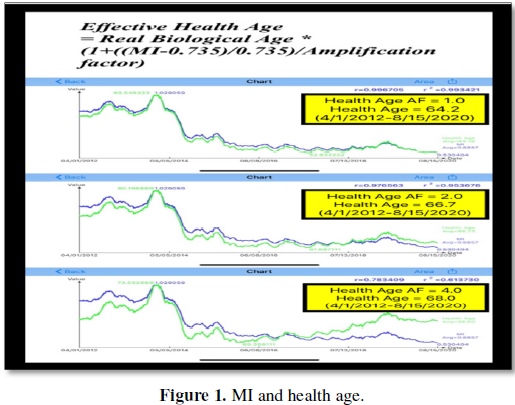

Figure 2 compares health ages against real ages. In this figure, the listed health ages and real ages are average ages of the period from 4/1/2012 to 8/15/2020. It should be noted that all of the figures in this article used a 90-days moving average of daily data. The age differences for different values of AF are listed as below:
AF = 1 (wide age gap):
Health age = 64.2 & real age = 69.3
AF = 2 (medium age gap):
Health age = 66.7 & real age = 69.3
AF = 4 (narrow age gap)
Health age = 68.0 & real age = 69.3
Since the author studied and analyzed his big data of medical conditions, lifestyle details, and metabolism indices over 8.5 years, he knows his own body’s health situation extremely well. Also, from 2017-2020, the difference between his medical conditions and the break-even line (0.735) is “smaller” than the difference between his lifestyle details and the break-even line (0.735). In other words, he managed his lifestyle details; therefore, his lifestyle details MI is much lower than his medical conditions MI. As a result, he was able to reduce his weight from 220 lbs. to 170 lbs. and lower his glucose values from 280 mg/dL to 108 mg/dL, which were incredible accomplishments. By using standard targets for an average person, he established the following values for weight as 170 lbs. (BMI 25) and glucose as 120 mg/dL. Therefore, his MI score from medical conditions (0.8127) is much higher than his MI score from lifestyle details (0.3912).
For example, the following table lists his three MI values for medical groups (4 categories), lifestyle group (6 categories), and the total group (10 categories) during the period from 1/1/2020 to 8/15/2020:
Medical group MI = 0.8127
Lifestyle group MI = 0.3912
Total group MI = 0.5543
(Break-even line is 0.735)
Based on reasons and justifications above, he feels that the AF value of 2 is a more suitable value to be used to calculate his health age.
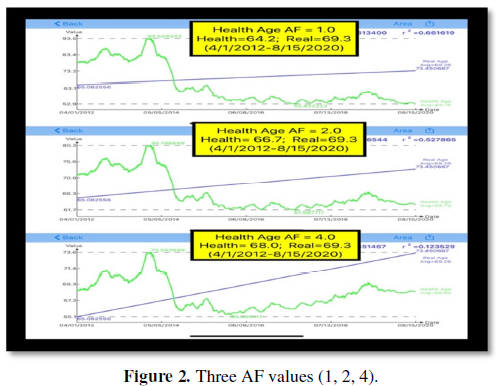
After determining 2 as his AF value, he will next examine his estimated health age in a more detailed manner.
Initially, he would like to determine the “turning point” date, where his health age equals to his real age, and when his MI value equals to 0.735. By using his big data analysis, he has identified that date to be 8/23/2014, his MI values just crossed the break-even line of 0.735 (Figure 3).
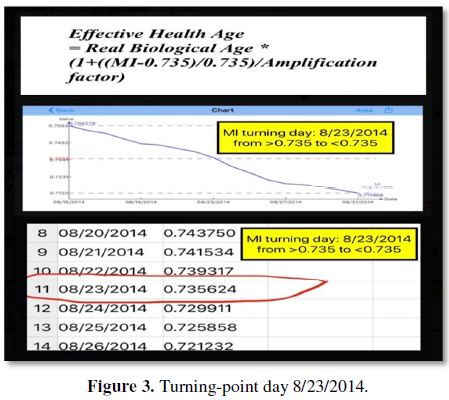

In Figure 4, he separates the period of 4/1/2012-8/15/2020 into two sub-periods, pre-turning sub-period of 4/1/2012-8/23/2014 with worse performance and post-turning sub-period of 8/23/2024-8/15/2020 with better performance. The following list demonstrates the age differences of these three groups:
Pre-turning (worse performance):
Health age = 74.5 & real age = 66.3
Post-turning (better performance):
Health age = 63.6 & real age = 70.5
Total period: (average performance)
Health age = 66.7 & real age = 69.3
From the information above, it is obvious that his health conditions have greatly improved; therefore, his body shows a younger age than his real age. As seen in Figure 5, it is clear that he has saved his own life, and hopefully, he can live a longer and healthier life.
Hsu [4-7] provide more detailed information regarding the MI model and its relationship with longevity.
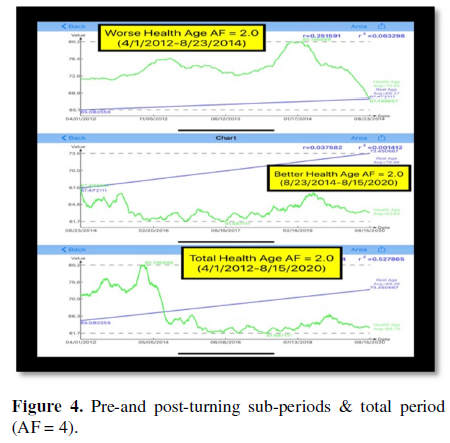
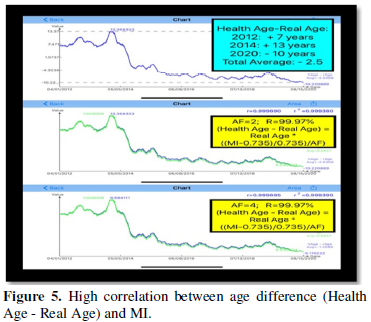


Conclusions
This article describes his sensitivity analysis in order to achieve a better estimated health age using MI scores as his tool. He decided to use the amplification factor (AF) This article describes his sensitivity analysis in order to achieve a better estimated health age using MI scores as his tool. He decided to use the AF value of 2 for the calculation of his estimated health age.
The difference between his health age and real age is -2.6 years using his “total average” daily data over 8.5 years from 1/1/2012 to 8/15/2020. However, by using his “annual” data for the calculation, then his age difference was +8 years in 2012 (health age was 72 with real age of 64) and -9 years in 2020 (health age is 64 with real age of 73).
This tool can be used by people with and without chronic diseases.
Metabolism is the fundamental building block for diabetes control, health maintenance, and longevity. The author developed this model, approach, and simple formula by himself; therefore, he must conduct research on this equation’s two vital influential factors, MI and AF. He spent 7 years on MI research and has a strong understanding of the MI’s applicability. AF is just a simple adjustment factor that makes the health age match closely to the user’s real medical and health conditions as much as possible. The author is not a fortune teller who uses a crystal ball to predict other people’s future life expectancy, but rather he is a scientist who applies solid scientific techniques with biomedical evidence to develop a simple arithmetic formula which can serve as a useful tool for the general population’s health maintenance and longevity purposes.
-
Hsu GC (2020) Effective health age resulting from metabolic condition changes and lifestyle maintenance program. MOJ Gerontol Ger 5(3): 1-3.
-
Hsu GC (2020) Estimation of Metabolism Index and Effective Health Age using a simple APP tool on the iPhone for chronic disease control and overall health maintenance using GH-Method: Math-physical medicine (No. 292). MOJ Gerontol Ger 5(4): 125-131.
-
Hsu GC (2018) Using Math-Physical Medicine to Analyze Metabolism and Improve Health Conditions (No. 005). 3rd International Conference on Endocrinology and Metabolic Syndrome.
-
Hsu GC (2020) Longevity analysis by comparing the overall metabolism and life routine regularity for two periods via GH-Method: Math-physical medicine (No. 282). Series Endo Diab Met 2(2): 1-5.
-
Hsu GC (2020) A geriatric study of longevity via big data analytics of metabolism, stress, and daily life routine using GH-Method: Math-physical medicine (No.283). MOJ Gerontol Gert 5(5): 150-155.
-
Hsu GC (2020) A geriatric study of longevity via big data analytics of metabolism and medical conditions using GH-Method: Math-physical medicine (No. 284). MOJ Gerontol Ger 5(5): 150-155.
-
Hsu GC (2020) A geriatric study of longevity via big data analytics of metabolism along with food, exercise, sleep, and water using GH-Method: Math-physical medicine (No. 285).
-
Hsu GC (2020) A simplified model for estimated Metabolism Index and Effective Health Age calculation using GH-Method: Math-physical medicine (No. 287).
QUICK LINKS
- SUBMIT MANUSCRIPT
- RECOMMEND THE JOURNAL
-
SUBSCRIBE FOR ALERTS
RELATED JOURNALS
- International Journal of Diabetes (ISSN: 2644-3031)
- Journal of Rheumatology Research (ISSN:2641-6999)
- Journal of Otolaryngology and Neurotology Research(ISSN:2641-6956)
- International Journal of Medical and Clinical Imaging (ISSN:2573-1084)
- Journal of Pathology and Toxicology Research
- Advance Research on Alzheimers and Parkinsons Disease
- BioMed Research Journal (ISSN:2578-8892)







